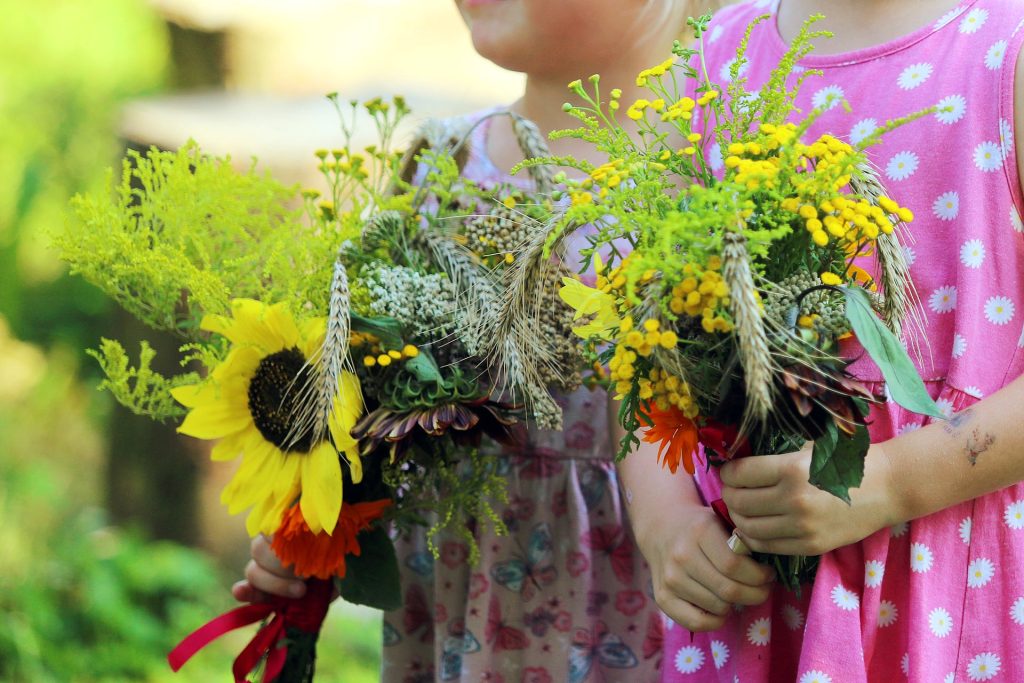Herbal Bouquets for Mary in Greater Poland
Share

In Dolsk, children from surrounding communities made herb bouquets for the Feast of the Assumption of the Blessed Virgin Mary. In the parish’s Hildegarnia herbal center – named after St. Hildegard – Aneta Grzelka runs “God and His Children” herbal workshops. For centuries, in Polish villages, the Assumption, traditionally known as the Feast of Our Lady of Herbs, has been a time for blessing bouquets made from herbs, flowers, and grains.
The children are invited to a meadow by the so-called “HildeHut.”. As Aneta explains to the Family News Service, herbs, flowers, and cereals are already prepared for them there, ready to be arranged into festive bouquets. “I called these workshops ‘God and His Children,’ meaning ‘a little bouquet.’ They are open to everyone, and sometimes I’m amazed at how many children come! We’ve never run out of herbs,” says Aneta Grzelka.
Bouquets for Our Lady of Herbs
The bouquets are crafted both according to St. Hildegard’s herbal recommendations and Polish folk tradition. They must include goldenrod [nawłoć in Polish] – here called “Our Lady’s herb.”
“It was called so because it always bloomed on September 8, the feast of Mary’s Nativity,” Aneta explains. “Before August 15, it’s still in bud, so people would gather it for the bouquet to thank Mary for the harvest.”

Inspiration Behind the Hildegarnia Workshops
The August workshops with children are the most important, Aneta leads, though Hildegarnia hosts activities year-round. Her interest in herbs began in childhood, when she helped her grandmother in the garden. “I’d help her pull weeds, and then we’d give them to the hens. Grandma said it would keep them healthy and make the eggs better. That got me curious – why would they be healthier?” she recalls.
One day, she found her grandmother’s book, Medicine from God’s Pharmacy, and discovered that many plants thrown to the hens were more valuable than the vegetables themselves.
“I once read a herbalist say that if we knew how many healing properties nettle has, we’d be growing nettles among our carrots – and pulling the carrots out. I loved that idea, and it inspired me so much that I’m still discovering new herbal plants all around me and ways to use them well,” Aneta says.
A Place of Peace and Harmony
Thanks to the parish priest’s support, a room in the rectory has been transformed into a herb-scented space – “a place that smells of St. Hildegard” – where visitors can find peace and the harmony that the saint often spoke about.
Aneta continues to encourage everyone who comes to notice the richness of nature around them. “I keep discovering new, wonderful things. And I think it will never end – just as God will never stop amazing us,” she says.
The Tradition of Blessing Herbs on Our Lady of Herbs Day
In Poland, this custom dates back to the Middle Ages, combining gratitude for the harvest with a prayer for God’s blessing. Bouquets include medicinal herbs, flowers, ears of grain, and sometimes vegetables or fruit. Once blessed, they are kept at home, believed to bring health, protection, and abundance. In many regions, certain plants – known as “Our Lady’s herbs” – are always included, such as tansy, mint, St. John’s wort, chamomile, and, of course, goldenrod.
Family News Service
Photos: Mirek Krajewski – Family News Service



